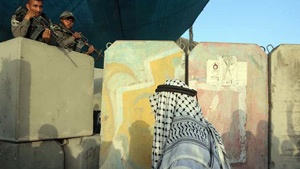Immediate Colonization of Occupied Territory
Israel’s colonization of Palestinian territory began immediately. On 11 June 1967, the second day of the occupation, Israel demolished the entire Magharib quarter of the Old City of Jerusalem with dynamite and bulldozers, destroying 135 homes and forcibly displacing 650 people, designating the entire area for ‘Jewish Quarter redevelopment’.[2] In the same month, Israel altered and expanded the municipal boundaries of Jerusalem to include 28 Palestinian villages in the West Bank.[3] According to Meron Benvenisti, the mayor of Jerusalem at the time, the expanded boundary was intended to incorporate ‘a maximum of vacant space with a minimum of Arabs’.[4] The following year, Israel issued a military order expropriating 29 acres of land in the south of the Old City for ‘public purposes’. Jewish families were transferred into the area to establish a Jewish presence thus altering the demography of the Old City. Between September 1967 and 1968, Israel authorized and constructed Gush Etzion, a Jewish settlement in Hebron, alongside settlements in the Jordan Valley, East Jerusalem and the Dead Sea. By the end of 1967, Yigal Allon, the Head of Israel’s Ministerial Committee for Settlements began to plan an official settlement map for Jewish settlements in the Eastern part of the West Bank.[5]
On 14 September 1967, Theodor Meron, Legal Advisor in Israel’s Ministry of Foreign Affairs warned that ‘in our settlement in Gush Etzion, evidence of intent to annex the West Bank to Israel can be seen’. Noting the absolute prohibition on settlement building under Article 49 of the Fourth Geneva Convention he suggested that settlements be carried out by military rather than civilian entities on a temporary basis, but warned that the international community had not accepted Israel’s arguments that ‘the West Bank is not “normal” occupied territory’.[6]It was evident that the Ministry of Foreign Affairs and the Political Secretary to the Prime Minister were put on notice that the colonization was unlawful but it continued regardless with the support of all organs of the State, including the judiciary. Indeed, Israel’s courts uphold the colonization of the occupied territory, deliberately refusing to apply Article 49 of the Fourth Geneva Convention to the occupied territory, perpetuating the colonization under a veneer of legality.[7]
In June 1969, Israel’s Prime Minster Gold Meir argued against the very existence of the Palestinian people, stating ‘It was not as though there was a Palestinian people in Palestine considering itself as a Palestinian people and we came and threw them out and took their country away from them. They did not exist’.[8] The statement cut to the core of Israel’s colonizing ideology.
While Israel’s colonizing plans in occupied territory were immediately apparent beginning in 1967, also immediately apparent was the international community’s failure to intervene to protect the occupied Palestinian population from the colonization. Apart from a myriad of General Assembly and Security Council resolutions, and an Advisory Opinion from the International Court of Justice on nuanced issues relating to the conflict, the international community has failed to trigger the necessary mechanisms at its disposal to counter the illegal appropriation of Palestinian territory. No economic sanctions were authorized against Israel, no peacekeeping troops or multinational forces were sent into the Occupied Palestinian Territory to end the occupation, and Israel has been allowed to act for fifty years with impunity under the shield of a non-existent ‘peace process’. Third States similarly failed Palestine for fifty years in their obligations ‘to respect and ensure respect’ for the Fourth Geneva Convention ‘in all circumstances’ failing to intervene to halt the colonization.
Conclusion
This week marks 50 years of Israel’s occupation of the Palestinian Territory and coincidentally marks the 40 year anniversary of the of the adoption of Additional Protocol I to the Geneva Conventions regulating armed conflicts ‘in which peoples are fighting against colonial domination and alien occupation and against racist régimes in the exercise of their right of self-determination.’[9]
Today there are 130 settlements and over 600,000 settlers in the West Bank, including East Jerusalem. There is no more time. The international community must intervene immediately and use all mechanisms at its disposal to end Israel’s military occupation and colonization of Palestinian territory.
[1]YoramDinstein, The International Law of Belligerent Occupation (Cambridge University Press, 2009) 270.
[2]Michael Dumper, ‘Israeli Settlement in the Old City of Jerusalem’ XXI (4) Journal of Palestine Studies (1992) 38.
[3]Abdel Monem Said Aly, Shai Feldman, Khalil Shikaki, Arabs and Israelis: Conflict and Peacemaking in the Middle East (Palgrave MacMillan, 2013) 130
[4]Hani Faris, The Failure of the Two-State Solution: The Prospects of One State in the Israel Palestine Conflict (I.B Taurus, 2013) 37.
[5]Paul Rivlin, The Israeli Economy from the Foundation of the State through the 21st Century (Cambridge University Press, 2011) 143.
[6] Ministry of Foreign Affairs, Settlement in the Administered Territories (18 September 1967)
[7] HCJ 698/80, Kawasma v. Minister of Defence; HCJ 5973/92 Association for Civil Rights in Israel et al. v. Minister of Defence et al.; YoramDinstein, The International Law of Belligerent Occupation, Cambridge, 2009.
[8] Carol Bisharat, ‘Palestine and Humanitarian Law: Israeli Practice in the West Bank and Gaza’ 12 Hastings International and Comparative Law Review (1988-1989) 325.
[9] Article 1(4)



